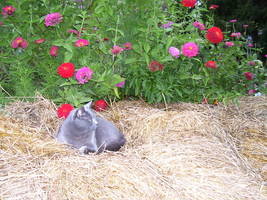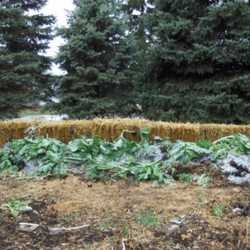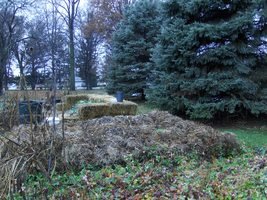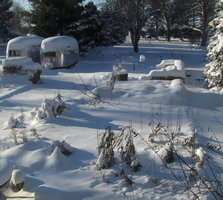





(Editor's Note: This article was originally published on January 17, 2008. Your comments are welcome, but please be aware that authors of previously published articles may not be able to respond to your questions.)
Forget about trying to layer green matter & figuring out which are the “browns,” forget about turning the pile, don’t bother to take its temperature, don’t stand by with a moisture meter all summer. Don’t worry about whether it’s OK to add to your compost in the winter. Just stop worrying & start building.
Do it my way. And you’ll have a tomato patch like the one at right.
I don’t care what you’ve heard, you can compost absolutely anything that will rot – leaves, pine needles, ashes, raw vegetable scraps, leftovers, dairy, meat, plain paper, newspaper, colored paper, wood, sawdust, roadkill. Even cat, dog & human waste, although that’s not for the inexperienced. We’ll get to that some other time.
This all-comers, laissez-faire approach to composting is part of a larger effort to produce as little trash as possible. If it is possible for me to use or treat the waste that my lifestyle produces right here on the property, then I believe it is my responsibility to do so. Sending my byproducts on down the line may make them disappear for the moment, but who knows when they will return in the water I drink, the air I breathe or the landscapes I love?
Here is one bonus of my rabid approach to composting everything that will rot: I haven’t had to take out my kitchen wastebasket in 3 weeks. And actually putting a trash barrel out for the garbage guys? That blessed event hasn't happened since sometime before Thanksgiving.
That makes me happy. So, if you’re interested, let’s take a tour of my compost, which is a living, breathing entity -- imbued with great personality.
So, if you’re interested, let’s take a tour of my compost, which is a living, breathing entity -- imbued with great personality.
This chunky piece of machinery (nicknamed "Julie")
mans the front lines, processing the tiny critters
that are often delivered with the straw.
"Julie" then stockpiles these treated ingredients
in a prominent spot, ready for me to retrieve & add to the compost.
As you can see below, my “bins” are more like compost corrals built with straw bales. Every year a local farmer delivers 100 bales to me, at around $2.50 apiece. The majority are earmarked for the new compost corral, but many of them go toward mulching my whole garden. When I moved onto this acre of land two winters ago & started my garden from scratch, I didn’t have the luxury of preparing any beds in the fall. But there was a delicious sandpit where a swingset had stood. That got the party started, mostly with strawberries & herbs. Next to that went the first compost corral, constructed of straw bales: 3 x 6 x 2 high, for a total of 36 bales. All summer long that corral ate up dozens of cardboard boxes from the move, all the trimmings from the garden, bags of shredded paper, carts of shredded leaves, everything I could throw at it.
Then it sat for a winter, as I shifted my compostables to a large trashcan within flinging reach, right outside the back door. This last spring, when the corral seemed almost full, I topped it off with thick pads of straw and planted tomatoes & melons into that. This worked out rather well, until those vines stole a car & made a break for the county line! 
In late fall, garden cleanup
creates a pile that will eventually
shrink to nearly nothing. This one,
situated on top of a year-old lasagna bed,
has been started off with several bags of shredded paper.
Meanwhile, as soon as the first corral got capped, Son of Compost Corral went up on a lasagna bed that won’t be ready till next spring. Here you can see its initial stages, a rich mixture of gone-to-seed cole crops, shredded paper, unshredded leaves, kitchen scraps, cardboard & a few unfortunate animals who didn’t survive their commute here on River Road. (My dearly departed pets get buried, but anonymous possums, well …)
As a sturdy new batch of bales
goes up in the background,
last year's corral slowly but faithfully implodes.
Keep in mind that the brown mush you see here
started out two bales high as well.
This spring, the original corral will be ready
to spread onto the rest of the garden
& I will gain the planting space where it stood.
With luck, I’ll also have filled Son
with enough biodegradables to cap it off & plant on top.
These compost corrals are the ultimate in all-season interest. In the summer the active corral is redolent of dill & mown grass, while the aging one sprouts a wild hairdo of happy plants. In fall, a mountain of fresh straw lines the driveway. In winter, I watch the old corral imploding impossibly on itself, feeling virtuous as the new one continues to fill.
A sublime sprinkling of snow
shows off the slow march
of the compost corrals up my one-acre lot
toward the road.
In spring, fresh compost gets my juices going in the precious weeks before planting commences.
It’s all good.
Maybe someday I’ll market all this muck under the name KISS Compost – Keep It Simple, Sweetie.
Copyright © www.100flowers.win Botanic Garden All Rights Reserved